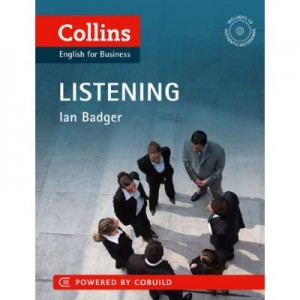Listening, by Ian Badger
 Image from here
Image from here
Specific rave
The recordings are the star feature of this publication by Ian Badger. They are gorgeous. They come in mp3 format on a data CD, and they vary in length from 22 seconds (message on telephone answering machine) to 2 minutes 44 seconds (registering for, and starting a conference call).
Being Dublin born, I focussed first on Owen from Dublin (Unit 6, Track 18) who says
|| it's the exACT opposite in GERmany ||
Listen to it below. play
The word ‘opposite‘ is non-prominent, between the two prominent syllables shown in upper case. It’s a case of what John Wells refers to as ‘downgrading’ (Wells, 2006: 228) or ‘the rule of three’ in his blogpost here. But what happens here goes further than simply a lessening of lexical stress – the word sounds and sounds monosyllabic, ‘opps‘ – its final two syllables are missing! It’s an example of the ind of phenomenon Sheila Thorn refers to when she argues that ‘… students need training in identifying the, often important, words in-between the stressed syllables’. (Thorn, 2009)
Back to Ian Badger’s book. There’s a mondegreen on Track 22 where a Chinese speaker’s ‘become used to China’ sounds like ‘become Mister China’. I would argue that this is not an error, but something that could happen with any speaker of any variety of English.
But my favourite track features a Southern USA accent. Tonya speaks about ‘tailgating’ (picnicking off the backs of trucks which have the tailgate down) and this word (including the ‘tailgate’ form) occurs seven times with different sound shapes: with some occurrences sounding like ‘tellgading’.
More generally
The publication’s aim is to ‘develop…awareness and sensitivity to different accents’ and the twenty chapters feature a total of fifty recordings of people from Northern Ireland, England, East and West USA, Peru, Thailand, South Africa and many other countries. All speaking unscripted. It can be used either in self-study or as supplementary materials on a business English course. A key feature of the book is its focus on vocabulary, and a major component of each unit is the Cobuild check which contains examples of vocabulary in use with a view to either expanding the users range of vocabulary (Unit 14, ‘world of finance’; Unit 11, ‘describing food and drink’) or showing different contexts in which the same word can be used (Unit 1 – regional, Unit 15 – redundancy).
Each unit has a pattern of: [1] listening comprehension, [2] focus on pronunciation/vocabulary/structure [3] gap filling [4] vocabulary work. Also included in many units are valuable cultural notes which may cover information about the variety of English that the accent represents (Unit 4 differences between UK and US English) or on behavioural differences between cultures (Unit 7 etiquette on meeting someone in India).
Good stuff! Looks as though it’ll be really good for Business English courses, with its mix of listening activities, wonderful range of accents, cultural information, and vocabulary building.
Thorn, S. (2009). Mining listening texts. Modern English Teacher, 18/2, 5-13
Wells, J.C. (2006) English Intonation: An introduction. Cambridge: Cambridge University Press.


Leave a Reply